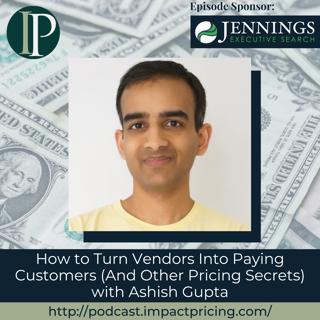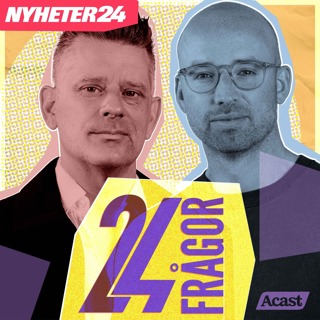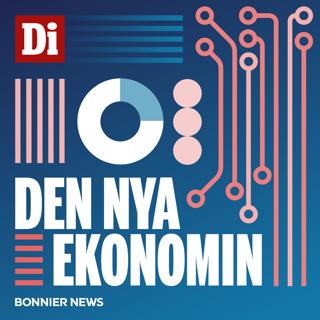
Cracking the Cold Outreach Code: Your Winning Formula for Value-Based Pricing Success with Mark Herring
Mark Herring is a passionate marketing leader with strong technical roots and deep knowledge of how to market cloud and enterprise software to open-source developers and DevOps audiences. He is the Chief Marketing Officer at HiveMQ. In this episode, Mark shares his approach to cold outreach, explaining why leading with recognizable brands before introducing value creates engagement. He explores effective email strategies, emphasizing the power of short, curiosity-driven messages over long, detailed pitches. He also discusses pricing from the buyer’s perspective, highlighting how perceived value—rather than just function—drives purchasing decisions. Why you have to check out today’s podcast: Learn proven strategies for grabbing attention in cold calls and emails, using brand credibility and psychological triggers like FOMO. Discover how to price based on what buyers truly value, rather than just cost or features, using real-life analogies. Get practical tips on structuring sales conversations to keep prospects engaged without sounding like a typical salesperson. “Try and understand the value in the eyes of your buyer. I think far too many times as vendors, we think there's intrinsic value because it costs us much to produce or we think it looks like that. It's trying to understand from a buying perspective, what is the value you're providing.” - Mark Herring Topics Covered: 01:29 - How his journey from development to product marketing led him to pricing 03:41 - How his early pricing research focused on how customers would use a product rather than explicitly asking about the problem it solved 04:59 - To what is the short tenure of CMOs in B2B and consumer goods attributed to 06:25 - Explaining what a pipeline is and how pipeline generation involves value demonstration 10:38 - Comparing pipeline to running a marathon, emphasizing that while MQLs and SQLs are useful stepping stones, the ultimate goal is generating real sales opportunities 12:02 - Differentiating a pipeline from a SQL 14:18 - Demonstrating how a successful cold outreach combines multiple touchpoints 18:57 - How to make prospects more receptive in a cold call 21:13 - Why he uses big brand names as conversation openers in cold calls rather than starting with a value statement 22:27 - What an effective cold email should be 24:42 - Highlighting the importance of A/B testing cold emails and continuously refining outreach strategies to improve open rates 25:55 - Mark's best pricing advice Key Takeaways: “It's cold because you've never had the interaction, but usually they've interacted somewhere with you. It's like they might have seen you at an event, or they might have seen some of your outreach to you already and going, ‘Okay, I'll give this guy a bone.’” - Mark Herring “One of the sales guys was talking about this [cold calls] at the conference we were at together, and I just loved it. And he is like, ‘Don't over research, because there's never a good time to know everything.’ Because you got to keep on dialing.” - Mark Herring “You can't stop doing it [cold outreach] because it's like getting dice and trying to get the six, the more you throw it, the better chance you're going to get to the six.” - Mark Herring “I lead [cold call] with brands, not with value. And when you do that type of thing, they're then shocked going, ‘Oh, he didn't do a sales pitch on me. He's asking me about these companies. Well, maybe it is something interesting.’” - Mark Herring People/Resources Mentioned: FedX: https://www.fedex.com/en-us/home.html UPS: https://www.ups.com/us/en/home Connect with Mark Herring: LinkedIn: https://www.linkedin.com/in/herringmark/ Email: mark.herring@hivemq.com Connect with Mark Stiving: LinkedIn: https://www.linkedin.com/in/stiving/ Email: mark@impactpricing.com
17 Mars 28min
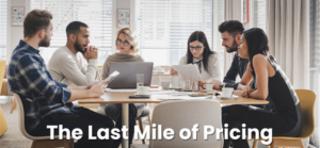
Blogcast: The Last Mile of Pricing
This is an Impact Pricing Blog published on January 13, 2025, turned into an audio podcast so you can listen on the go. Read Full Article Here: https://impactpricing.com/blog/the-last-mile-of-pricing/ If you have any feedback, definitely send it. You can reach us at mark@impactpricing.com. Now, go make an impact. Connect with Mark Stiving: Email: mark@impactpricing.com LinkedIn: https://www.linkedin.com/in/stiving/
14 Mars 2min
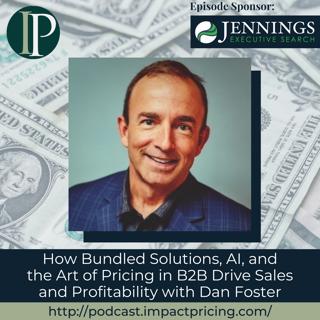
How Bundled Solutions, AI, and the Art of Pricing in B2B Drive Sales and Profitability with Dan Foster
Dan Foster is a Chief Operating/Revenue Officer, who built and transformed profitable businesses across technology and telecom start-ups as well as industry powerhouses. Companies turn to him to revive struggling businesses by redefining sales, marketing and customer service strategy, scaling infrastructure, and promoting product innovation. In this episode, Dan shares how bundled solutions increase value and close rates. He discusses AI’s growing role in B2B sales and procurement. And stresses using data to understand customer needs and justify pricing. Why you have to check out today’s podcast: Learn how bundling products and services can enhance perceived value, increase close rates, and prevent price-sensitive buyers from deconstructing your offerings. Gain insights into how AI is transforming the sales landscape, from optimizing product recommendations to procurement teams using AI to negotiate better prices. Understand why pricing should be tied to the customer’s business outcomes and how to communicate the true value of your solutions effectively. "You take the data around a pricing example and you really understand the value from the end user's perspective, so you got to have that empathy back in to say what moves their business. And when we understand what moves their business with a few numbers, then you start to give the underpinning for why value pricing matters." - Dan Foster Topics Covered: 02:01 - How his early consulting work made him think about value and led him to pricing 03:23 - Asking about typical reactions to pricing presentations 04:24 - Explaining that selling value starts with understanding product-market fit 07:03 - Highlighting the importance of teaching distribution partners how to sell value, using the Home Depot-SolarCity partnership as an example 10:43 - How can ROI calculators be convincing 14:07 - Explaining that while they don't track proven value directly due to lack of data, anecdotal feedback and supplier insights indicate improved close rates for partners 15:09 - How AI is reshaping product offerings, expanding technology advisors' roles, and influencing cost-cutting for innovation 19:10 - Highlighting that while AI may drive procurement efficiencies complex digital transformation solutions still rely on expertise 20:27 - How bundling simplifies purchasing and reinforce the value of an all-in-one solution 24:27 - Dan's best pricing advice Key Takeaways: "If you want to buy a ton of storage and it's a commodity, we get that. That could go through the marketplace earlier than not. If you want a digital transformation, if you want to change your customer experience, if you want to make your business run faster, if you want business process automation and robotic process automation, that's not going through a dynamic pricing model on a marketplace near-term. Now, can I go out and look at, like, UiPath Licensing versus Automation Anywhere versus whoever Microsoft scooped up next and look at pricing models? The procurement folks are probably smart to do that." - Dan Foster "But the bundled solution specifically is, I think, fundamental because otherwise, when you offer them the menu-based pricing, oftentimes they don't see the full value." - Dan Foster "It [selling value] starts with that product-market fit. We do a lot of enablement of our partners or downstream almost like a two-tier distributor. And in doing that we provide the ability for them to see a higher close rate when they use tools and resources. It alleviates that conversation and it's inherent that there's value pricing there." - Dan Foster "It's critical to think through in a subscription-based model what that value is, because that customer acquisition cost versus the long-term value of a customer, it's a critical ratio to understand when you're thinking through pricing." - Dan Foster People/Resources Mentioned: Cummins Engine Company: https://www.cumminsenginepart.com/ Unilever: https://www.unilever.com Alcoa: https://www.alcoa.com/global/en/home/ Amazon: https://www.amazon.com/Selling-Value-Deals-Higher-Prices/product-reviews/1737655217/ref=cm_cr_dp_d_show_all_btm?ie=UTF8&reviewerType=all_reviews& SolarCity: https://en.wikipedia.org/wiki/SolarCity Home Depot: https://www.homedepot.com Azure: https://azure.microsoft.com/ Google: https://www.google.com/?client=safari Lowe's: https://www.lowes.com Sun Power: https://us.sunpower.com Sunrun: https://www.sunrun.com TD Synnex: https://www.tdsynnex.com/na/us/ Ingram Micro: https://www.ingrammicro.com Five9: https://www.five9.com Genesys: https://www.genesys.com/en-sg/ NICE inContact: https://www.nice.com/ Zoom: https://zoom.us Dialpad: incontact.com/content/home.htm ChatGPT: https://chatgpt.com Wall Street Journal: https://www.wsj.com/ Automation Anywhere: https://www.automationanywhere.com Microsoft: https://www.microsoft.com/en-ph/ UiPath Licensing: https://licensing.uipath.com/ Hulu: https://www.hulu.com/welcome?orig_referrer=https%3A%2F%2Fwww.google.com%2F Roku TV: https://www.roku.com/products/roku-tv?srsltid=AfmBOoomwWI9G8ZABYW7gSPFzBHc87xVmartPBXAWzj7GfPfAJQYjTtO Super Bowl: https://en.wikipedia.org/wiki/Super_Bowl Xfinity: https://www.xfinity.com/ Connect with Dan Foster: LinkedIn: https://www.linkedin.com/in/jdanfoster/ Email: dfoster@telarus.com Connect with Mark Stiving: LinkedIn: https://www.linkedin.com/in/stiving/ Email: mark@impactpricing.com
10 Mars 27min

Blogcast: Understanding Context: 4 Key Factors That Influence Customer Willingness to Pay
This is an Impact Pricing Blog published on January 6, 2025, turned into an audio podcast so you can listen on the go. Read Full Article Here: https://impactpricing.com/blog/understanding-context-4-key-factors-that-influence-customer-willingness-to-pay/ If you have any feedback, definitely send it. You can reach us at mark@impactpricing.com. Now, go make an impact. Connect with Mark Stiving: Email: mark@impactpricing.com LinkedIn: https://www.linkedin.com/in/stiving/
7 Mars 3min
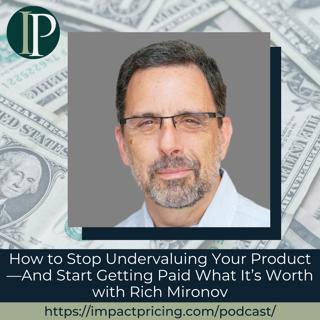
How to Stop Undervaluing Your Product—And Start Getting Paid What It’s Worth with Rich Mironov
Rich Mironov provides product management leadership and coaching to large and small tech companies, with more than 150 clients since 2001. His focus includes: Coaching VPs of Product and CPOs, Organizing the product organization, and Stepping in (occasionally) as a 'smokejumper' VP of Product Management. In this episode, Rich shares that product managers must define economic value before development. He believes sales teams should communicate, not calculate, value using simple tools. And he advises focusing on broad market data instead of over-relying on top accounts. Why you have to check out today’s podcast: Learn how to define and communicate economic value effectively. Understand how sales teams and product managers can align for better pricing decisions. Gain actionable tips on framing value in sales conversations without overwhelming buyers. “You want to look for an aggregate set of data about what's happening in your marketplace as opposed to attaching a lot of overweight to your two largest accounts.” - Rich Mironov Topics Covered: 01:22 - Describing his journey into product management and an overview of his role here 03:40 - Differentiating B2C pricing versus B2B pricing as it relates to product management 09:33 - Discussing the balance between standardized pricing for most customers and the reality of frequent one-off deals in B2B 11:28 - How to systematize B2B pricing to reduce one-off deals and encourage standardization 16:59 - Aligning sales compensation with margin to protect long-term profitability 18:39 - Highlighting how enterprise sales teams generalize individual client demands as market-wide needs 20:26 - Why product teams must define economic value before development 25:00 - Agreeing that product teams must define value early but debates how to present it, with Mark favoring customer-driven insights and Rich emphasizing the need for quantifiable justification to close deals 26:25 - Acknowledging that while ROI calculators aren’t inherently trusted, they’re valuable as a conversational tool 28:37 - Rich's best pricing advice Key Takeaways: "I believe a fundamental obligation of product management if we're building something that needs this kind of discussion [communicate economic value], is to do the economic math before we start the development. Not after." - Rich Mironov "Expecting my sales team to be economists is unrealistic. And so, on the product side, I feel like I owe my sales team some narrative that they can read off the page, yes, fill in the numbers, fill in the values, or fill in the quantities. But the value story has to be baked into the product." - Rich Mironov "We lead with benefits, we lead with stories, we lead with vignettes, we lead with problems. But the last two paragraphs of that have to justify somebody actually signing a contract." - Rich Mironov People/Resources Mentioned: JPMorganChase: https://www.jpmorganchase.com New York Stock Exchange: https://www.nyse.com/index Connect with Rich Mironov: LinkedIn: https://www.linkedin.com/in/richmironov/ Website: mironov.com Email: rich@mironov.com Connect with Mark Stiving: LinkedIn: https://www.linkedin.com/in/stiving/ Email: mark@impactpricing.com
3 Mars 30min

Blogcast: Dynamic vs. Stable Context: A Framework for Smarter Pricing
This is an Impact Pricing Blog published on December 23, 2024, turned into an audio podcast so you can listen on the go. Read Full Article Here: https://impactpricing.com/blog/dynamic-vs-stable-context-a-framework-for-smarter-pricing/ If you have any feedback, definitely send it. You can reach us at mark@impactpricing.com. Now, go make an impact. Connect with Mark Stiving: Email: mark@impactpricing.com LinkedIn: https://www.linkedin.com/in/stiving/
28 Feb 3min
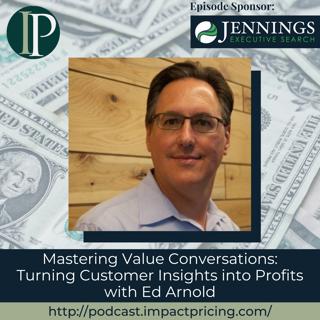
Mastering Value Conversations: Turning Customer Insights into Profits with Ed Arnold
Ed Arnold works with B2B companies to develop their value-based pricing strategies. His specialty is translating a company’s competitive advantage into a viable customer value pricing strategy, as well as advising on commercial execution. In this episode, Ed shares when value conversations are most effective. He highlights the need to tailor value models to each prospect through open-ended questions that uncover key business drivers. Because when value is clearly demonstrated, price becomes a secondary concern, resulting in smoother sales and fewer pricing objections. Why you have to check out today’s podcast: Learn why guiding customers to do their own value math is more persuasive than presenting a pre-made ROI model. Discover how value conversations shift the focus from cost to impact, making price negotiations smoother. Understand why dumping numbers on customers backfires and how to engage them in a way that builds trust and buy-in. "As customers, we have a good sense of what a great deal is. But as sellers, we're much less certain about what that value is. You need to have value conversations to get at that." - Ed Arnold Topics Covered: 00:57 - How he accidentally got into, left, and keeps returning to pricing 03:25 - Explaining how pricing challenges often signal deeper business issues 08:46 - Why customers distrust ROI calculators 11:05 - What value conversation is all about and how to effectively go through it 14:00 - Emphasizing that trust is built through reliability and honest engagement 16:57 - How many good salespeople are there and what make good salespeople 19:17 - The importance of market focus and playbooks in sales 20:49 - Showing the most effective value conversation to have 25:03 - How he trains salespeople on value conversations 29:53 - Noting that while he focuses on larger customers, the same value-based principles apply to marketing lower-ACV products 30:24 - Ed's best pricing advice Key Takeaways: "You cannot solve any pricing issue without tackling the strategy. And if the strategy is flawed, then the pricing isn't going to help you." - Ed Arnold "...and this is the thing that I think about value stories. It's not about the product. It's about the customer. The customer is the star of the story." - Ed Arnold People/Resources Mentioned: Steven Forth: https://www.linkedin.com/in/stevenforth/ Forrester: https://www.forrester.com/bold/ Monitor Deloitte: https://www.deloitte.com/global/en/services/consulting/services/monitor-deloitte.html Leverage Point: https://www.leveragepoint.com/ Connect with Ed Arnold: LinkedIn: https://www.linkedin.com/in/edarnold1/ Connect with Mark Stiving: LinkedIn: https://www.linkedin.com/in/stiving/ Email: mark@impactpricing.com
24 Feb 30min

Blogcast: Value Drivers vs. Value Tables: When to Go Broad and When to Be Specific
This is an Impact Pricing Blog published on December 16, 2024, turned into an audio podcast so you can listen on the go. Read Full Article Here: https://impactpricing.com/blog/value-drivers-vs-value-tables-when-to-go-broad-and-when-to-be-specific/ If you have any feedback, definitely send it. You can reach us at mark@impactpricing.com. Now, go make an impact. Connect with Mark Stiving: Email: mark@impactpricing.com LinkedIn: https://www.linkedin.com/in/stiving/
21 Feb 4min
